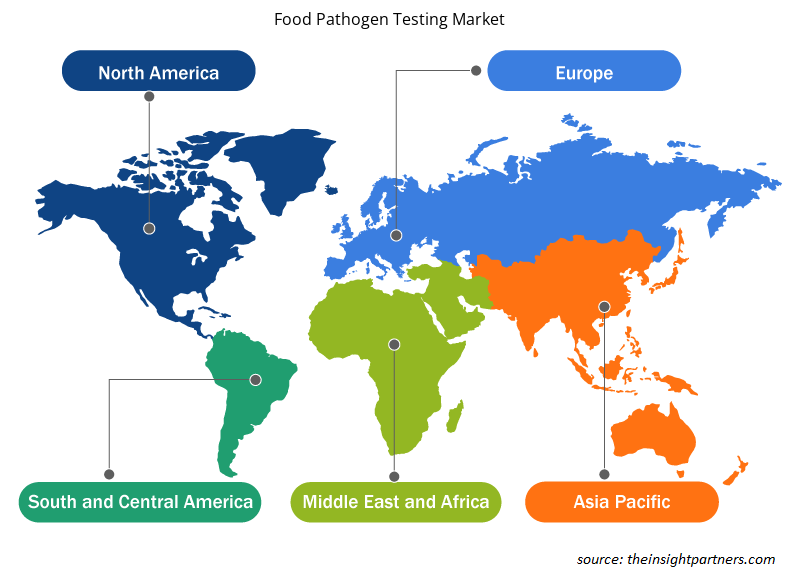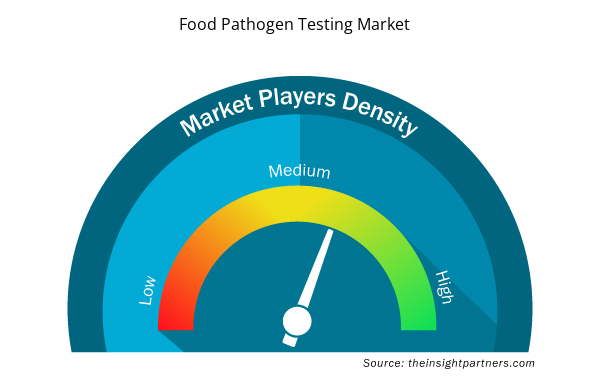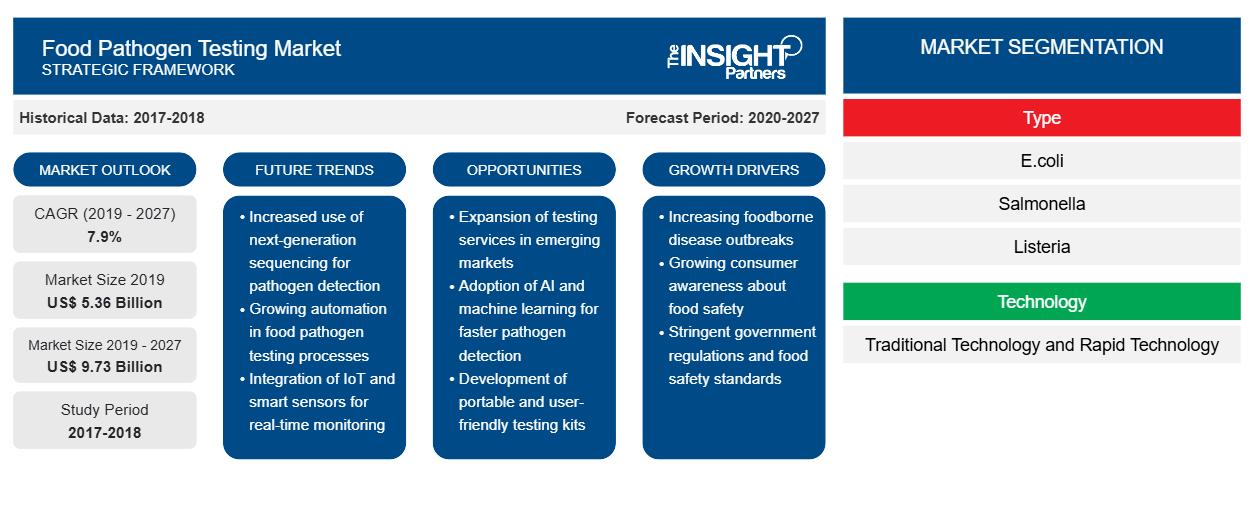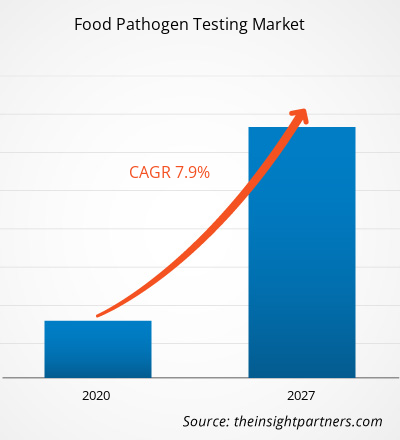食品病原体検査市場は2019年に53億6,094万米ドルと評価され、2027年までに97億3,191万米ドルに達すると予測されており、2020年から2027年にかけて7.9%のCAGRで成長すると予想されています。
食品病原体検査は、食品中の生命を脅かす細菌や微生物の存在を監視するのに役立つプロセスとして定義されています。有害な食中毒を引き起こす可能性のある病原体を引き起こすウイルスや細菌が約 31 種類知られているため、食品病原体検査は主に食品業界にとって重要です。この検査方法は、食品の安全性を確保するために、食品生産のあらゆる段階で採用されています。食中毒の症例数の増加による安全性への懸念と規制の増加は、食品病原体検査の市場の成長を促進しています。また、ポリメラーゼ連鎖反応や免疫磁気分離などのさまざまな食品病原体検査方法の進歩と検出時間の制限により、食品業界のさまざまな関係者が食品病原体検査を採用するようになりました。
ヨーロッパの食品病原体検査市場は、予測期間中に最高のCAGRで成長すると予想されています。この地域の市場の成長は、主に、食中毒の発生率の上昇とそれに伴う食品安全に対する意識の高まりにより、北米での食品病原体検査の需要が高まっていることに起因しています。ナノバイオテクノロジーと相まって病原体検査方法の発展も、市場の成長を支えています。医療費の増加と食品・飲料業界での遺伝子組み換え生物の応用も、同じ市場の原動力となっています。食品貿易のグローバル化と経済発展は、この地域の食品病原体検査市場の拡大に貢献しています。食品の消費者と製造業者の間で食品病原体検査の採用の利点についての意識が高まっていることは、食品病原体検査市場の発展に有利な機会を提供します。
要件に合わせてレポートをカスタマイズする
このレポートの一部、国レベルの分析、Excelデータパックなど、あらゆるレポートを無料でカスタマイズできます。また、スタートアップや大学向けのお得なオファーや割引もご利用いただけます。
- このレポートの主要な市場動向を入手してください。この無料サンプルには、市場動向から見積もりや予測に至るまでのデータ分析が含まれます。
COVID-19パンデミックが食品病原体検査市場に与える影響
COVID-19の発生は、ロックダウン、渡航禁止、事業停止により、さまざまな国の経済や産業に悪影響を及ぼしています。食品と飲料は、サプライチェーンの制限や生産工場の閉鎖など、深刻な混乱に見舞われている重要な産業の1つです。さまざまな国のさまざまな工場や工場の閉鎖により、グローバルサプライチェーンが混乱し、製造活動、配送スケジュール、さまざまな商品の販売に悪影響を及ぼしています。さまざまな企業がすでに、製品の配送の遅延や製品の将来の販売の低迷の可能性を発表しています。さらに、ヨーロッパ、アジア、北米の国々が課した世界的な渡航禁止は、ビジネスコラボレーションやパートナーシップの機会を妨げています。したがって、これらの要因は、食品および飲料業界の食品病原体検査市場の成長を抑制しています。
市場分析
乳製品生産における迅速な病原体検査の増加が食品病原体検査市場の成長を促進すると予想される
食品病原体検査技術は、食品安全技術の進化に伴い、継続的に強化され、採用されています。今日の乳製品生産者は、さまざまな製品、施設、ワークフローに適した、正確で迅速な病原体検査のさまざまなオプションから選択できます。迅速な食品病原体検査技術は、最も効果的かつ効率的な方法で標的病原体を検出することを目的としたさまざまな化学に基づいています。酵素結合蛍光アッセイ (ELFA) ベースの技術は、病原体の特定の細胞表面受容体を標的にして識別を行います。ポリメラーゼ連鎖反応 (PCR) ベースの技術は、各病原体内の DNA を標的とします。
乳製品工場に迅速検査技術を導入すると、結果が出るまでの時間が短くなるなど、多くの利点があります。これにより、生産効率の向上、製品の保管時間の短縮、製品の保存期間の延長を目的として、さらに高い検査が可能になります。迅速検査技術の使用は、有害事象への対応を迅速化することにもつながり、乳製品生産施設は、廃棄や腐敗による損失を防ぐために必要な是正措置を実施できます。さらに、これらの食品病原菌の迅速検査方法は使いやすく、人員の柔軟性が高まります。乳製品メーカーのほとんどは、社内検査プログラムを導入しています。適切なトレーニングと適切な機器の可用性があれば、高度な微生物学の学位は、病原菌検査プログラムの導入を阻む障壁にはなりません。また、迅速検査方法のアクセス性と手頃な価格が高まったため、乳製品メーカーはデータを社内で保持し、サンプルと結果の追跡可能性と管理を強化できます。データの活用と保管は、メーカーが分析を採用し、サプライチェーンから生産ライン、保管施設に至るまで積極的な意思決定を行うのにさらに役立ちます。迅速な病原体検査によって得られる利点により、乳製品メーカーはそれを自社の製造部門に導入し、それが食品病原体検査市場の成長を促進しています。
タイプインサイト
食品病原体検査市場は、種類によって、ブランチング済みと天然の2つに分かれています。サルモネラセグメントは2018年に大きな市場シェアを占め、予測期間中に市場でより高いCAGRを記録すると予想されます。サルモネラ菌は、人体の腸管に影響を及ぼす最も一般的な細菌性疾患です。下痢、腹部のけいれん、発熱を引き起こします。主に、生または加熱不足の肉、鶏肉、卵製品の摂取が原因です。サルモネラ菌感染症は、特に幼児、女性、成人の免疫系を弱めます。時には命を脅かすこともあるため、食品病原体検査は主にサルモネラ菌に対して行われます。サルモネラ菌感染症のリスクは非常に高く、人は簡単に感染します。したがって、この感染症と人命損失を防ぐために、食品病原体検査はこの分野で非常に重要な役割を果たしており、食品病原体検査市場の成長を促進しています。
食品の種類に関する洞察
食品の種類に基づいて、食品病原体検査市場は、肉類、乳製品、加工食品、果物と野菜、穀類と穀物に分類されます。肉類と鶏肉のセグメントは、2018年に最大の市場シェアを占めました。世界の肉の消費は、タンパク質摂取量の向上や屋外での夕食への支出の増加など、健康上の利点により大幅に増加しています。消費者の意識と健康意識の高まりにより、製品の品質を改善または維持する必要性から、食品病原体検査の需要が高まっています。鶏肉、肉、魚介類製品を介した食品病原体の発生増加に起因する規制の策定は、セグメントの成長を増幅します。肉類と鶏肉に関連する最も重要な病原体は、大腸菌、カンピロバクター、サルモネラです。皮剥ぎや羽毛除去中の不衛生な状態や不適切な取り扱いにより、汚染が予想され、このセグメントの成長を支えています。
テクノロジーインサイト
技術に基づいて、食品病原体検査市場は、従来の技術と迅速技術に分かれています。迅速技術セグメントは、2018年に最大の市場シェアを占めました。従来の技術に関連する簡単な手順と低い初期コストが、このセグメントの成長を支えています。コストの削減や精度の向上など、さまざまな利点があり、このセグメントの成長を促進する可能性があります。従来の技術は非常に正確ですが、病原体の検出にかなりの時間がかかります。数日から数週間かかることもあります。さらに、食品微生物学研究所は過去30年間で大きく変化しました。1980年代初頭には、メーカーが社内で行っていた品質管理テストに重点が置かれていました。しかし、業界が食品安全管理にHACCPアプローチを採用し始めたため、品質管理は品質保証に置き換えられました。検出ではなく、予防が食品安全管理の目標となり、残りの微生物学的検査の多くは外部委託されました。従来の技術は、サンプル内の微生物を培養して検出に十分な細胞を生成することに引き続き依存していました。この培養ステップには少なくとも 24 時間かかり、病原菌によっては 5 日以上かかることもあります。従来の方法では、HACCP システムの重要管理点を効果的に監視するのに十分な速さで結果を出すことができず、現在は主にシステムが正しく機能しているかどうかを確認するために使用されています。
食品病原体検査市場で活動している企業としては、SGS SA、Bureau Veritas、Intertek Group Plc、Eurofins Scientific、Mérieux NutriSciences、ifp Institut für Produktqualität GmbH、ALS Limited、AsureQuality、Microbac Laboratories、FoodChain ID Group Inc などがあります。主要企業は合併や買収、研究開発戦略を実施して顧客基盤を拡大し、世界市場で大きなシェアを獲得し、世界的にブランド名を維持しています。
食品病原体検査市場の地域別洞察
予測期間を通じて食品病原体検査市場に影響を与える地域的な傾向と要因は、Insight Partners のアナリストによって徹底的に説明されています。このセクションでは、北米、ヨーロッパ、アジア太平洋、中東、アフリカ、南米、中米にわたる食品病原体検査市場のセグメントと地理についても説明します。

- 食品病原体検査市場の地域別データを入手
食品病原体検査市場レポートの範囲
| レポート属性 | 詳細 |
|---|---|
| 2019年の市場規模 | 53.6億米ドル |
| 2027年までの市場規模 | 97億3千万米ドル |
| 世界のCAGR(2019年 - 2027年) | 7.9% |
| 履歴データ | 2017-2018 |
| 予測期間 | 2020-2027 |
| 対象セグメント | タイプ別
|
| 対象地域と国 | 北米
|
| 市場リーダーと主要企業プロフィール |
|
市場プレーヤーの密度:ビジネスダイナミクスへの影響を理解する
食品病原体検査市場は、消費者の嗜好の変化、技術の進歩、製品の利点に対する認識の高まりなどの要因により、エンドユーザーの需要が高まり、急速に成長しています。需要が高まるにつれて、企業は提供を拡大し、消費者のニーズを満たすために革新し、新たなトレンドを活用し、市場の成長をさらに促進しています。
市場プレーヤー密度とは、特定の市場または業界内で活動している企業または会社の分布を指します。これは、特定の市場スペースに、その市場規模または総市場価値に対してどれだけの競合相手 (市場プレーヤー) が存在するかを示します。
食品病原体検査市場で事業を展開している主要企業は次のとおりです。
- SGS SA
- ビューローベリタス
- インターテックグループ
- ユーロフィンサイエンティフィック
- メリュー ニュートリサイエンス。
免責事項:上記の企業は、特定の順序でランク付けされていません。

- 食品病原体検査市場のトップキープレーヤーの概要を入手
レポートの注目点
- 食品病原体検査市場における進歩的な業界動向は、プレーヤーが効果的な長期戦略を策定するのに役立ちます。
- 先進国市場と発展途上国市場で採用されているビジネス成長戦略
- 2019年から2027年までの食品病原体検査市場の定量分析
- 食品病原体検査の世界的需要の推定
- 業界で事業を展開するバイヤーとサプライヤーの有効性を示すPEST分析
- 競争市場の状況を理解するための最近の動向
- 食品病原体検査市場の成長を牽引・抑制する要因と市場動向および展望
- 商業的利益の基盤となる市場戦略を強調し、市場の成長につながる意思決定プロセスを支援する
- 食品病原体検査市場の規模はさまざまなノードで
- 市場の詳細な概要とセグメンテーション、および食品病原体検査業界の動向
- 有望な成長機会があるさまざまな地域の食品病原体検査市場の規模
食品病原体検査市場 - タイプ別
- 大腸菌
- サルモネラ
- リステリア
- カンピロバクター
- その他
食品病原体検査市場 – 技術別
- 伝統技術
- ラピッドテクノロジー
食品病原体検査市場 – 食品タイプ別
- 肉類と鶏肉
- 乳製品
- 加工食品
- 果物と野菜
- 穀物
企業プロフィール
- SGS SA
- ビューローベリタス
- インターテックグループ
- ユーロフィンサイエンティフィック
- メリュー ニュートリサイエンス。
- ifp Institut für Produktqualität GmbH
- ALSリミテッド
- アシュアクオリティ
- マイクロバックラボラトリーズ
- フードチェーンIDグループ株式会社
- 過去2年間の分析、基準年、CAGRによる予測(7年間)
- PEST分析とSWOT分析
- 市場規模価値/数量 - 世界、地域、国
- 業界と競争環境
- Excel データセット



Report Coverage
Revenue forecast, Company Analysis, Industry landscape, Growth factors, and Trends

Segment Covered
This text is related
to segments covered.

Regional Scope
North America, Europe, Asia Pacific, Middle East & Africa, South & Central America

Country Scope
This text is related
to country scope.
よくある質問
Global meat consumption has increased tremendously owing to its health benefits, such as improved protein intake coupled with a rise in spending on outdoor dinners. The necessity to improve or maintain the product quality due to growing consumer awareness and health consciousness drives the food pathogen testing demand. Developing regulations attributed to increasing food pathogen outbreaks through poultry, meat, and seafood products amplify the segment growth. The most important pathogens associated with meat and poultry are E. coli, campylobacter, and Salmonella. Unhygienic conditions and improper handling during skinning and de-feathering results in contamination anticipated supporting this segment growth.
The major players operating in the global pathogen testing market are SGS SA, Bureau Veritas, Intertek Group Plc, Eurofins Scientific, Mérieux NutriSciences., ifp Institut für Produktqualität GmbH, ALS Limited, AsureQuality, Microbac Laboratories, and FoodChain ID Group Inc, among others.
In 2019, the pathogen testing market was predominant in North America at the global level. North America encompasses an ample amount of opportunities for the growth of pathogen testing. The rise in the incidence of foodborne diseases and thus the rising awareness towards food safety drives the demand for food pathogen testing in North America. Development in pathogen testing methods coupled with nano-biotechnology also supports the growth of the market. Increments in medical expenses and the application of genetically modified organisms in food & beverages industry also fuels the market for the same.
Trends and growth analysis reports related to Consumer Goods : READ MORE..
The List of Companies - Global Food Pathogen Testing Market
- SGS SA
- Bureau Veritas
- Intertek Group Plc
- Eurofins Scientific
- Mérieux NutriSciences.
- ifp Institut für Produktqualität GmbH
- ALS Limited
- AsureQuality
- Microbac Laboratories
- FoodChain ID Group Inc
The Insight Partners performs research in 4 major stages: Data Collection & Secondary Research, Primary Research, Data Analysis and Data Triangulation & Final Review.
- Data Collection and Secondary Research:
As a market research and consulting firm operating from a decade, we have published and advised several client across the globe. First step for any study will start with an assessment of currently available data and insights from existing reports. Further, historical and current market information is collected from Investor Presentations, Annual Reports, SEC Filings, etc., and other information related to company’s performance and market positioning are gathered from Paid Databases (Factiva, Hoovers, and Reuters) and various other publications available in public domain.
Several associations trade associates, technical forums, institutes, societies and organization are accessed to gain technical as well as market related insights through their publications such as research papers, blogs and press releases related to the studies are referred to get cues about the market. Further, white papers, journals, magazines, and other news articles published in last 3 years are scrutinized and analyzed to understand the current market trends.
- Primary Research:
The primarily interview analysis comprise of data obtained from industry participants interview and answers to survey questions gathered by in-house primary team.
For primary research, interviews are conducted with industry experts/CEOs/Marketing Managers/VPs/Subject Matter Experts from both demand and supply side to get a 360-degree view of the market. The primary team conducts several interviews based on the complexity of the markets to understand the various market trends and dynamics which makes research more credible and precise.
A typical research interview fulfils the following functions:
- Provides first-hand information on the market size, market trends, growth trends, competitive landscape, and outlook
- Validates and strengthens in-house secondary research findings
- Develops the analysis team’s expertise and market understanding
Primary research involves email interactions and telephone interviews for each market, category, segment, and sub-segment across geographies. The participants who typically take part in such a process include, but are not limited to:
- Industry participants: VPs, business development managers, market intelligence managers and national sales managers
- Outside experts: Valuation experts, research analysts and key opinion leaders specializing in the electronics and semiconductor industry.
Below is the breakup of our primary respondents by company, designation, and region:

Once we receive the confirmation from primary research sources or primary respondents, we finalize the base year market estimation and forecast the data as per the macroeconomic and microeconomic factors assessed during data collection.
- Data Analysis:
Once data is validated through both secondary as well as primary respondents, we finalize the market estimations by hypothesis formulation and factor analysis at regional and country level.
- Macro-Economic Factor Analysis:
We analyse macroeconomic indicators such the gross domestic product (GDP), increase in the demand for goods and services across industries, technological advancement, regional economic growth, governmental policies, the influence of COVID-19, PEST analysis, and other aspects. This analysis aids in setting benchmarks for various nations/regions and approximating market splits. Additionally, the general trend of the aforementioned components aid in determining the market's development possibilities.
- Country Level Data:
Various factors that are especially aligned to the country are taken into account to determine the market size for a certain area and country, including the presence of vendors, such as headquarters and offices, the country's GDP, demand patterns, and industry growth. To comprehend the market dynamics for the nation, a number of growth variables, inhibitors, application areas, and current market trends are researched. The aforementioned elements aid in determining the country's overall market's growth potential.
- Company Profile:
The “Table of Contents” is formulated by listing and analyzing more than 25 - 30 companies operating in the market ecosystem across geographies. However, we profile only 10 companies as a standard practice in our syndicate reports. These 10 companies comprise leading, emerging, and regional players. Nonetheless, our analysis is not restricted to the 10 listed companies, we also analyze other companies present in the market to develop a holistic view and understand the prevailing trends. The “Company Profiles” section in the report covers key facts, business description, products & services, financial information, SWOT analysis, and key developments. The financial information presented is extracted from the annual reports and official documents of the publicly listed companies. Upon collecting the information for the sections of respective companies, we verify them via various primary sources and then compile the data in respective company profiles. The company level information helps us in deriving the base number as well as in forecasting the market size.
- Developing Base Number:
Aggregation of sales statistics (2020-2022) and macro-economic factor, and other secondary and primary research insights are utilized to arrive at base number and related market shares for 2022. The data gaps are identified in this step and relevant market data is analyzed, collected from paid primary interviews or databases. On finalizing the base year market size, forecasts are developed on the basis of macro-economic, industry and market growth factors and company level analysis.
- Data Triangulation and Final Review:
The market findings and base year market size calculations are validated from supply as well as demand side. Demand side validations are based on macro-economic factor analysis and benchmarks for respective regions and countries. In case of supply side validations, revenues of major companies are estimated (in case not available) based on industry benchmark, approximate number of employees, product portfolio, and primary interviews revenues are gathered. Further revenue from target product/service segment is assessed to avoid overshooting of market statistics. In case of heavy deviations between supply and demand side values, all thes steps are repeated to achieve synchronization.
We follow an iterative model, wherein we share our research findings with Subject Matter Experts (SME’s) and Key Opinion Leaders (KOLs) until consensus view of the market is not formulated – this model negates any drastic deviation in the opinions of experts. Only validated and universally acceptable research findings are quoted in our reports.
We have important check points that we use to validate our research findings – which we call – data triangulation, where we validate the information, we generate from secondary sources with primary interviews and then we re-validate with our internal data bases and Subject matter experts. This comprehensive model enables us to deliver high quality, reliable data in shortest possible time.


 このレポートの無料サンプルを入手する
このレポートの無料サンプルを入手する